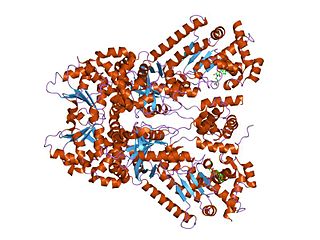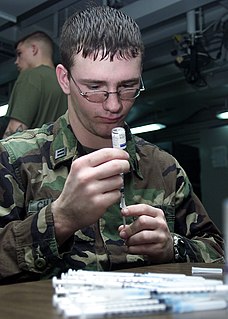 W
WAnthrax is an infection caused by the bacterium Bacillus anthracis. It can occur in four forms: skin, lungs, intestinal and injection. Symptom onset occurs between one day to over two months after the infection is contracted. The skin form presents with a small blister with surrounding swelling that often turns into a painless ulcer with a black center. The inhalation form presents with fever, chest pain, and shortness of breath. The intestinal form presents with diarrhea which may contain blood, abdominal pains, nausea, and vomiting. The injection form presents with fever and an abscess at the site of drug injection.
 W
WAnthrax toxin is a three-protein exotoxin secreted by virulent strains of the bacterium, Bacillus anthracis—the causative agent of anthrax. The toxin was first discovered by Harry Smith in 1954. Anthrax toxin is composed of a cell-binding protein, known as protective antigen (PA), and two enzyme components, called edema factor (EF) and lethal factor (LF). These three protein components act together to impart their physiological effects. Assembled complexes containing the toxin components are endocytosed. In the endosome, the enzymatic components of the toxin translocate into the cytoplasm of a target cell. Once in the cytosol, the enzymatic components of the toxin disrupts various immune cell functions, namely cellular signaling and cell migration. The toxin may even induce cell lysis, as is observed for macrophage cells. Anthrax toxin allows the bacteria to evade the immune system, proliferate, and ultimately kill the host animal. Research on anthrax toxin also provides insight into the generation of macromolecular assemblies, and on protein translocation, pore formation, endocytosis, and other biochemical processes.
 W
WAnthrax vaccine adsorbed (AVA) is the only FDA-licensed human anthrax vaccine in the United States. It is produced under the trade name BioThrax by the Emergent BioDefense Corporation in Lansing, Michigan. The parent company of Emergent BioDefense is Emergent BioSolutions of Rockville, Maryland. It is sometimes called MDPH-PA or MDPH-AVA after the former Michigan Department of Public Health, which formerly was involved in its production.
 W
WThe Anthrax Vaccine Immunization Program (AVIP), is the name of the policy set forth by the U.S. federal government to immunize its military and certain civilian personnel with the BioThrax anthrax vaccine. It began in earnest in 1997 by the Clinton administration. Thereafter it ran into Food and Drug Administration (FDA) and judicial obstacles. Over 8 million doses of BioThrax were administered to over 2 million U.S. military personnel as part of the program between March 1998 and June 2008.
 W
WVaccines against the livestock and human disease anthrax—caused by the bacterium Bacillus anthracis—have had a prominent place in the history of medicine, from Pasteur’s pioneering 19th-century work with cattle to the controversial late 20th century use of a modern product to protect American troops against the use of anthrax in biological warfare. Human anthrax vaccines were developed by the Soviet Union in the late 1930s and in the US and UK in the 1950s. The current vaccine approved by the U.S. Food and Drug Administration (FDA) was formulated in the 1960s.
 W
WBacillus anthracis is a Gram-positive and rod-shaped bacterium that causes anthrax, a deadly disease to livestock and, occasionally, to humans. It is the only permanent (obligate) pathogen within the genus Bacillus. Its infection is a type of zoonosis, as it is transmitted from animals to humans. It was discovered by a German physician Robert Koch in 1876, and became the first bacterium to be experimentally shown as a pathogen. The discovery was also the first scientific evidence for the germ theory of diseases.
 W
WHarsh Vardhan Batra is an Indian scientist working in animal biotechnology at the Department of Biotechnology (DBT), of the Indian Ministry of Science and Technology. He is a former director of the Defence Food Research Laboratory (DFRL), a Defence Research and Development Organisation (DRDO) establishment at Mysore. As a specialist in infectious diseases, he participated in the DRDO biodefence preparedness program, and was an expert member of the technical advisory committee on plague constituted by the government of India in September 1994. He served as technical consultant for the design and construction of high containment laboratories for DRDO, the Indian Council for Agricultural Research (ICAR) and Indian Council of Medical Research (ICMR). He participated in the United Nations Biological Weapons Convention (BTWC) ad hoc group meetings in Geneva as a member of the Indian delegation, and conducted World Health Organization (WHO) Southeast Asia Regional Office meetings and workshops on infectious diseases.
 W
WDr. Friederich Eurich (1867–1945) was a German bacteriologist.